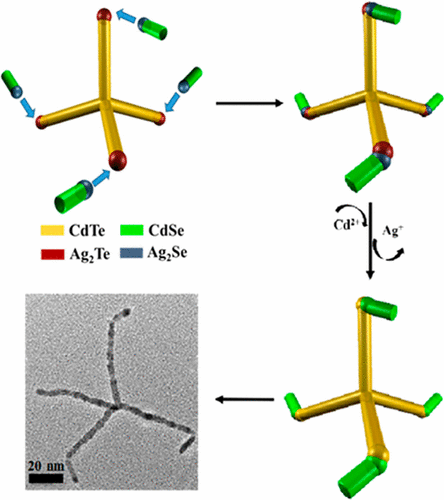当前位置:
X-MOL 学术
›
Chem. Mater.
›
论文详情
Our official English website, www.x-mol.net, welcomes your feedback! (Note: you will need to create a separate account there.)
Hierarchical Multicomponent Nanoheterostructures via Facet-to-Facet Attachment of Anisotropic Semiconductor Nanoparticles
Chemistry of Materials ( IF 8.6 ) Pub Date : 2017-10-31 00:00:00 , DOI: 10.1021/acs.chemmater.7b02676 Shashank Gupta 1 , Wen-Ya Wu 2 , Sabyasachi Chakrabortty 1 , Mingjie Li 1 , Yi Wang 1 , Xuanwei Ong 1 , Yinthai Chan 1, 2
Chemistry of Materials ( IF 8.6 ) Pub Date : 2017-10-31 00:00:00 , DOI: 10.1021/acs.chemmater.7b02676 Shashank Gupta 1 , Wen-Ya Wu 2 , Sabyasachi Chakrabortty 1 , Mingjie Li 1 , Yi Wang 1 , Xuanwei Ong 1 , Yinthai Chan 1, 2
Affiliation

|
As performance and functionality requirements for solution-processed nanomaterials become more stringent and demanding, there is an ever-growing need for hierarchical nanostructures with sophisticated architecture and complex composition. However, the production of structurally complex nanomaterials is often not possible by direct synthesis. In this work, we describe synthetic methodology to covalently link presynthesized anisotropic semiconductor nanoparticles of different composition in a stoichiometrically controlled manner via specific facet sites at room temperature. We demonstrate that CdSe nanorods can be cojoined with CdTe tetrapods via a competitive cation-exchange process with Ag+ that results in linking between the tips of the tetrapod arms with only one end of each nanorod via a Ag2Se–Ag2Te interface. This selective linking was engineered by having a large fraction of CdSe nanorods present in the reaction, which sterically hindered homolinking between Ag2Se-tipped CdSe nanorods and Ag2Te-tipped CdTe tetrapods with themselves. Cation back-exchange with Cd2+ and a size-selective purification to remove unlinked products yields samples enriched in heterolinked CdTe tetrapod–CdSe nanorod structures. High-resolution transmission electron microscopy and energy-dispersive X-ray spectroscopy confirmed the structure and composition of the nanorod-linked tetrapods, while time-resolved and pump-dependent photoluminescence data were consistent with a type II band offset at the CdTe–CdSe interface. The synthetic approach to colloidal nanoheterostructures described here is highly distinct from traditional methods involving a series of nucleation and growth steps at elevated temperature.
中文翻译:

通过各向异性半导体纳米粒子的小平面到正射键连接的多层多组分纳米异质结构
随着对溶液处理的纳米材料的性能和功能要求变得越来越严格和苛刻,对具有复杂结构和复杂组成的分级纳米结构的需求日益增长。但是,通常不可能通过直接合成来生产结构复杂的纳米材料。在这项工作中,我们描述了在室温下通过特定的刻面位置以化学计量控制的方式将不同组成的预合成各向异性半导体纳米粒子共价连接的合成方法。我们证明CdSe纳米棒可以通过与Ag +的竞争性阳离子交换过程与CdTe四足动物共联,从而导致四足动物臂的尖端与通过Ag 2的每个纳米棒的一端之间的连接。Se–Ag 2 Te界面。通过在反应中存在很大比例的CdSe纳米棒来设计这种选择性连接,这在空间上阻碍了Ag 2 Se掺杂的CdSe纳米棒与Ag 2 Te掺杂的CdTe四脚架之间的均相连接。用Cd 2+进行阳离子交换通过大小选择纯化去除未连接的产物,可得到富含杂化的CdTe四脚架–CdSe纳米棒结构的样品。高分辨率透射电子显微镜和能量色散X射线光谱学证实了纳米棒连接的四脚架的结构和组成,而时间分辨和泵浦依赖的光致发光数据与CdTe–CdSe界面处的II型谱带偏移一致。 。本文所述的胶体纳米异质结构的合成方法与传统方法高度不同,传统方法涉及在高温下的一系列成核和生长步骤。
更新日期:2017-10-31
中文翻译:

通过各向异性半导体纳米粒子的小平面到正射键连接的多层多组分纳米异质结构
随着对溶液处理的纳米材料的性能和功能要求变得越来越严格和苛刻,对具有复杂结构和复杂组成的分级纳米结构的需求日益增长。但是,通常不可能通过直接合成来生产结构复杂的纳米材料。在这项工作中,我们描述了在室温下通过特定的刻面位置以化学计量控制的方式将不同组成的预合成各向异性半导体纳米粒子共价连接的合成方法。我们证明CdSe纳米棒可以通过与Ag +的竞争性阳离子交换过程与CdTe四足动物共联,从而导致四足动物臂的尖端与通过Ag 2的每个纳米棒的一端之间的连接。Se–Ag 2 Te界面。通过在反应中存在很大比例的CdSe纳米棒来设计这种选择性连接,这在空间上阻碍了Ag 2 Se掺杂的CdSe纳米棒与Ag 2 Te掺杂的CdTe四脚架之间的均相连接。用Cd 2+进行阳离子交换通过大小选择纯化去除未连接的产物,可得到富含杂化的CdTe四脚架–CdSe纳米棒结构的样品。高分辨率透射电子显微镜和能量色散X射线光谱学证实了纳米棒连接的四脚架的结构和组成,而时间分辨和泵浦依赖的光致发光数据与CdTe–CdSe界面处的II型谱带偏移一致。 。本文所述的胶体纳米异质结构的合成方法与传统方法高度不同,传统方法涉及在高温下的一系列成核和生长步骤。



























 京公网安备 11010802027423号
京公网安备 11010802027423号